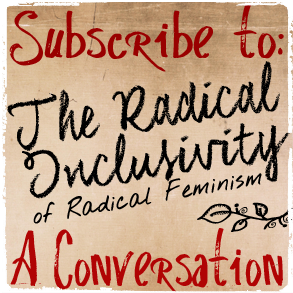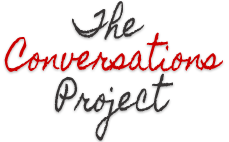Pt. 4, Sex Pedagogy: Essentialism as Praxis
Pt. 3, To Question Sex Pedagogy
January 23, 2016A Note from the Turf War Zone: Second Wave Erasure
January 27, 2016Radical feminist John Stoltenberg responds to trans feminist Cristan Williams‘ commentary on sex pedagogy noting that his long-term analysis has always been that sex is constructed to support gendered patriarchy. Stoltenberg also considers the ways in which trans and intersex individuals are posing serious challenges to the maintenance and promulgation of sex as a natural binary body system.
Keywords: Sex Gender Social Constructionism Gender Theory
BY John Stoltenberg
@JohnStoltenberg
 I’m very glad that you’ve found reading my work and Andrea’s “a breath of fresh air.” Thank you so much for saying so.
I’m very glad that you’ve found reading my work and Andrea’s “a breath of fresh air.” Thank you so much for saying so.
From where I’m coming—immersed in a radical feminism I first learned from Andrea—I too have had a hard time puzzling out how and why a particular conception of radical feminism has become so intent on defending the material existence of a sex binary even as it claims to want the social and political abolition of gender. From what I can understand, they consider themselves gender abolitionists, which I personally have no issue with. In my heart I’m a gender abolitionist too, in the sense that I would like to see what I’ve termed the end of manhood.1 But depending ideologically upon the dubious premise of sex essentialism as a means to achieve the desirable promise of the end of gender hierarchy has simply not computed for me. To me it’s like saying (to use my color-wheel metaphor), “Oh sure, we want a rainbow future, that sounds like a wonderful idea, but only if all the colors are based on the primary colors pink and baby blue.”
And I agree that the hypothesis of an essential sex binary in the human species is failing scientifically. When I wrote “How Men Have (a) Sex” in 1985, I told a parable to explain all the science I could find out at the time about our species’ multisexual complexity, and I summarized my findings and my tale this way:
[W]e are not born belonging to one or the other of two sexes. We are born into a physiological continuum on which there is not discrete and definite point that you can call “male” and no discrete and definite point that you can call “female.” If you look at all the variabilities in nature that are said to determine human “sex,” you can’t possibly find one that will unequivocally split the species into two. Each of the so-called criteria of sexedness is itself a continuum—including chromosomal variables, genital and gonadal variations, reproductive capacities, endocrinological proportions, and any other criteria you could think of. Any or all of these different variables may line up in any number of ways, and all of the variables may vary independently of one another.2
I recall that when I wrote that, originally as a speech, I was terrified about what people would think or do when they heard it. I knew what I was saying was heresy. To my surprise, the sky did not fall. That speech went on to be one of my most anthologized essays. And I can’t help but marvel that—as that Nature article you cited shows—science just keeps finding more and more validation of that heresy.
Not only is sex essentialism failing scientifically, of course; it is falling from credibility in the everyday lives of trans and intersex people, to say nothing of the myriad individuals who identify as agender, genderqueer, and so on. Luckily it fell from credibility in my life too: I grew up raised to be a man and never felt like a real one, only ever a failure or at best an imposter. Around the time I turned 30, I was fortunate to realize (upon reading Andrea’s Woman Hating) that I had been aspiring to a fiction, which meant I could let that fake aspiration go and say so to the world (as I did when I wrote “Why I Stopped Trying to Be a Real Man.”)
I’m not saying that my biographical experience equates with that of someone trans or intersex. That would be presumptuous if not disrespectful. But what I am saying is that I believe from personal experience, and from talking with other individuals raised to be a man who were never at ease behind that false front, that what goes by the name gender dysphoria is far more commonplace and variegated (to use the color wheel again) than anybody can yet imagine. And I would not be the least bit surprised if one day science discovers that not only are humans born physiologically along multiple continuums of so-called sexedness; but also, as humans are subsequently socialized into polar male-supremacist gender templates, their abreactions to that trauma are on multiple continuums. One day—perhaps when humans are all more honest with ourselves and one another—finding individuals without gender dysphoria may prove more challenging than locating needles in haystacks.
I want that day to come. So to me the time we’re in looks like a period of positive transition headed more or less in a revolutionary direction, no small thanks to brave outliers who have declared disloyalty to the sex binary fallacy. Meanwhile insistence on the sex binary looks to me like a reactionary movement backward.
I want to be clear: I’m not singling out here the abovementioned mistaken radical feminists, because insistence on the sex binary shows up in diverse ideological guises, including both men’s rights activism and masculinities studies (aka men’s studies). The former is blatantly antifeminist (as goes without saying, really); the latter likes to think of itself as profeminist. But what they have in common is their deep investment in believing in the existence of biological men. In my radical feminist critique of the construct “manhood,” I view manhood as the unitary fiction to which all people raised to be a man must aspire, in one way or another, mainly by incessant dominance contests that define who is a real man and who’s a wuss—i.e., feminized. Manhood in my analysis is like the true north by which all males-assigned-at-birth must navigate their identity as if magnetically in order to stay safe from dreaded identification with the derided status female. Except there’s nothing true about it. Manhood is but a shared delusion—there’s no there there—but the belief in manhood is a dangerous and destructive force field, with dangerous and destructive consequences, and it must be resisted in action ethically—i.e. by “refusing to be a man.” Masculinities studies, on the contrary, believe there is a there there, and all that’s needed, they say in their reformist way, is recognition of the multitudinous ways that biologically magnetized males align themselves in relation to it—i.e., in the form of diverse “masculinities.” Since the masculinities trope arose in the 1980s, I’ve always thought it bogus, because it does nothing to repudiate the central sex-essentialist fiction that biological manhood exists. But that fiction is a core precept of masculinities theorizing. Trans men by their very existence are messing with this core precept. And in their own way trans women by their very existence are messing with a core precept of radical feminists who maintain the category biological women as a universal verity. Whatever individual trans folks’ political views, their existence is threatening the conservatism of sex essentialism across a broad spectrum of sex-and-gender fundamentalists. And in this respect, I believe, trans folks are only today’s front lines. My hunch is that there are legions of others who have yet to get that they’ve been told to live lies of sex and gender.
What you are reading is a conversation between Cristan Williams and John Stoltenberg that began more than a year ago. In April 2014 John published a personal essay about Andrea Dworkin, his life partner for thirty-one years, titled “Andrea Dworkin Was Not Transphobic.” Cristan happened to read it and had a question for John, which she asked him in the comment thread. Unaware of who Cristan was, John replied. Shortly thereafter Cristan contacted John asking if he would be willing to be interviewed in The TransAdvocate, where she is managing editor. One email led to another and before long the two were writing back and forth in what became a wide-ranging, nearly book-length conversation. After several months, they realized what it was all about: “the radical inclusivity of radical feminism,” a conviction that both Cristan and John deeply share. That conversation, which is ongoing, is being published for the first time in installments on this site.
